 |
 |
Irina Sandu, Physical Processes Team Leader at ECMWF and Bjorn Stevens, Max Planck Institute for Meteorology
People have always been fascinated even by the mere possibility of a preview of what is coming. Foretellers, such as Nostradamus, have long been celebrated for such purposes. Nowadays, modern science actually has demonstrated an ability to predict, or foretell, some aspects of the future. Most notably the weather, with forecasts showing tremendous skill on the timescale of days, and utility lingering on timescales of weeks to months, and perhaps longer. Climate projections have also been accurate: initial estimates of the global mean temperature change based on simple models constructed forty years ago have proven remarkably prescient.
Accurate weather predictions and climate projections are used by national meteorological services to protect lives and property and to enhance the vitality of human society, in part through the ability to help us to define strategies to limit global warming and adapt to climate change.
Meteorologists and climate scientists are in a way today’s foretellers – differing from the foretellers of the past, in that their predictions rely on modern Earth science and the amazing capabilities it has wrought from advances in information technology.
These capabilities, of predicting the weather, monitoring the evolving state of the climate and estimating how it will change, have steadily improved in the last decades. Our glimpses into the weather and climate of the future are now on the verge of getting even better, thanks to recent advances in Earth system modelling and information technology, especially supercomputing, supported by a plethora of coordinated European efforts.
Here we present a new H2020 project – NextGEMS, which aims to substantially increase the realism of Earth system simulations. Two global storm-resolving Earth system models will be developed – with resolutions of 2 to 5 km in the atmosphere and ocean. At these resolutions, important phenomena like deep convection and mesoscale ocean eddies become resolved. The models will be applied to study the Earth system and how its climate will change over the next three decades. The project will start on 1 September 2021 and run for 4 years.
By developing the next-generation of global storm-resolving Earth-system models, NextGEMS thus supports and contributes to ECMWF and Europe’s ambitions to significantly advance our prediction capabilities at all timescales. Simulations at these scales will underpin both operational ECMWF forecasts by the end of the decade, and European efforts to create replicas of the Earth system in the European Commission’s Destination Earth programme.
Building on a rich past
Numerical weather prediction has experienced a quiet revolution in the last decades. The quality of global weather forecasts, such as those produced by ECMWF for its Member and Co-operating States, has continuously and significantly increased due to improvements in numerical models, observations, data assimilation and ensemble prediction techniques, much of which has been enabled by advances in supercomputing technologies. Progress in climate modelling is most evident through its incorporation of additional processes, which allow the models to be applied to a wider range of questions. Efforts to increase the physical fidelity of the simulations continues to be frustrated by an inability of existing models to explicitly represent processes on the scales at which they are either understood or observed. Whereas numerical weather prediction has quietly increased its social utility through more accurate short- to medium-term forecasts of devastating extreme events such as floods, hurricanes, droughts and wind-storms, climate scientists have struggled to similarly improve the regional fidelity of their projections, even when using high-resolution downscaling techniques.
The accumulation of errors arising from a poor representation of small-scale processes in today’s global climate models is believed to be a major obstacle to an improved representation of the global climate and its evolution. Climate models tile the globe, with individual elements much larger (by a factor of ten) than the dominant processes controlling the vertical energy fluxes in the atmosphere, or the high-latitude weather of the ocean. Only phenomena taking place at scales larger than these elements are modelled explicitly with the basic laws of physics; processes taking place at smaller scales, such as clouds or small hills or ocean eddies for example, are to a certain extent left to the bounty of our imagination – more in the tradition of Nostradamus.
The time is ripe to overcome some of the remaining challenges
A real breakthrough in our ability to forecast the weather and to predict how the climate will change at regional scales is now in reach. This is largely possible due to the latest advances in supercomputing, including the emergence of exascale computing, and to the substantial efforts made in the last years in Europe to adapt our weather and climate modelling capabilities and their underlying infrastructures to novel supercomputing architectures. These efforts were supported by a substantial investment from both the European Union and its Member States, for example in the framework of the Scalability Programme coordinated by ECMWF (see ECMWF Technical Memoranda and Bauer et al., 2021), a plethora of H2020 proposals it encompassed (see ESiWACE for example), and national efforts such as the HD(CP)2.
Global simulations at a resolution of a few kilometres, fine enough to be capable of representing circulations that surge through the depth of the troposphere, regulating its ability to mediate the exchange of energy between the surface and the atmosphere, have long been the stuff of science fiction. But recently efforts to reclaim more ground from Nostradamus have been gaining steam. Recently, ECMWF has made the first-ever global simulation at 1km resolution for an entire season, on one of the fastest computers in the world at the Oak Ridge National Laboratory in the US. In the framework of ESiWACE, scientists at the Max Planck Institute for Meteorology (MPI-M) in Germany, together with colleagues at the University of Tokyo, have coordinated a first comparison of storm-resolving atmosphere-only simulations. They are now organising a follow-on initiative in which the first multi-annual coupled storm-resolving simulations are being run. At storm-resolving (2 to 5 km) scales, many more important physical processes can be directly resolved by the laws of physics, thereby reducing some of the limitations of today’s climate models. These simulations thus offer a real promise of increased accuracy for weather and climate predictions.
To fully exploit this potential, however, a number of scientific challenges need to be overcome, related for example to the coupling between the different Earth system components, to the representation of processes which remain unresolved or to (water and energy) balance and conservation issues. ECMWF’s participation in NextGEMS will allow us to focus on some of these challenges, e.g. a more accurate representation of moist physics, and of the land and ocean and of their coupling to the atmosphere at these scales, and will thus support the science agreed in the ECMWF 2021 to 2030 strategy.
NextGEMS’ central idea and objectives
Taking advantage of these recent advances and opportunities, and strong institutional commitment at the modelling centres involved (MPI-M, ECMWF and the Alfred Wegener Institute), NextGEMS will focus on the development of two storm-resolving Earth system models (SR-ESMs).
Experience running uncoupled models at storm-resolving scales on smaller domains or for short time periods gives promise to the idea that SR-ESMs will not only reduce critical and long-standing biases that have and continue to plague conventional Earth system models, but also open new scientific frontiers.
For the first time the globe will be represented on the same scale as it is observed and the impacts of its weather extremes are felt. So, even without a change in quality, SR-ESMs provide a much more natural link to both users and observations. For these reasons, SR-ESMs are envisioned as a Flagship Activity of the World Climate Research Programme entitled Digital Earths, and as the substrate for ‘Digital Twins’, one of two scientific pillars for Europe’s new initiative, Destination Earth.
NextGEMS will lead the development of the two European prototype SR-ESMs participating in the DYAMOND initiatives, ICON from MPI-M and IFS from ECMWF (coupled with the ocean models NEMO and FESOM-2), into SR-ESMs and will perform the first multi-decadal (30 year) SR-ESM-based projections. It will apply the SR-ESMs to some of the biggest knowledge gaps in weather and climate science and show their added value for societal applications and as a new basis for innovation across Europe. It will also build new, more integrated, communities of ESM users and more directly involve non-scientific users in model development, thereby fostering knowledge co-production. In so doing it will provide the scientific foundation for Destination Earth and other scientific initiatives arising in response to the European Union’s Green Deal.
Collaboration and communication at the heart of NextGEMS
The computational and data demands of SR-ESMs exceed the competencies and capabilities of any single lab, and often of any single country. They require new workflows and more inclusive ways of working. This is why hackathons will be a central element in NextGEMS. Hackathons are communal exploration, analysis and development activities – they prioritise learning from each other by working with one another – active learning, rather than lecturing. At NextGEMS meetings, our fingers will do the talking. Hackathons build on experiences gained from the DYAMOND initiative, which enabled the project to involve a large international community in the analysis of the model output.
NextGEMS will make extensive use of Knowledge Co-production Hackathons both to advance model development and to develop pilot projects on risk assessment, near-surface renewable energy production, and coastal marine ecosystems and fisheries together with users from relevant sectors. NextGEMS will also put a significant emphasis on science communication. It will not only communicate its results to the outside world, but also empower its scientists as communicators through their active involvement in the NextGEMS vlog (Figure 1).

Figure 1. NextGEMS Video Communication Concept (Vlog) developed in co-operation with Latest Thinking (GmbH).
Through these activities, NextGEMS will form the nucleus of a next-generation, more cooperative and pan-European approach to Earth system modelling (Figure 2).

Figure 2. NextGEMS partners (magenta circles) and hackathons planned for non-partner institutions (grey circles). The lead coordinator will be Bjorn Stevens, Irina Sandu will act as co-coordinator and the NextGEMS project office will be at MPI-M.
Top banner credit: yokeetod/iStock/Getty Images Plus
